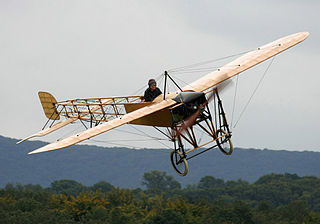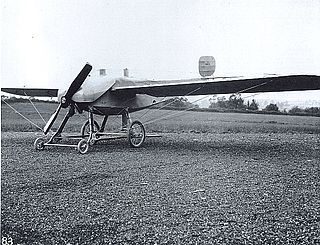| Prier monoplane | |
|---|---|
 | |
| Role | |
| Manufacturer | Bristol Aeroplane Company |
| Designer | Pierre Prier |
| First flight | 1911 |
| Number built | 34 |
The Bristol Prier monoplane was an early British aircraft produced in a number of single- and two-seat versions.
| Prier monoplane | |
|---|---|
 | |
| Role | |
| Manufacturer | Bristol Aeroplane Company |
| Designer | Pierre Prier |
| First flight | 1911 |
| Number built | 34 |
The Bristol Prier monoplane was an early British aircraft produced in a number of single- and two-seat versions.
The Bristol Prier Monoplanes were a series of tractor configuration monoplanes designed for the Bristol and Colonial Aeroplane Company by Pierre Prier, the former chief pilot of the Bleriot school at Hendon, who had joined Bristol in July 1911. At this time Bristol lacked a designer, George Challenger and Archibald Low having left the company to work for Vickers's newly established aircraft division.
Unsurprisingly, the Bristol Prier monoplanes resembled the successful Blériot XI monoplane, with a fabric-covered wire-braced wood fuselage and parallel-chord wings using wing-warping for lateral control, although differing in details. The all-moving tailplane was an elongated fan-shape, mounted in a mid-position between the upper and lower longerons, and the undercarriage had a pair of wheels on an axle mounted onto a pair of forward-projecting skids. It was powered by a 50 hp (37 kW) Gnome rotary engine. The first aircraft built (works No. 46) had been intended to compete in the Gordon Bennett Trophy race, but it was not ready in time. Two more aircraft, nos. 56 and 57, with a revised engine mounting, were started with the intention of taking place in the Daily Mail Circuit of Britain race.
Work was then started on developing a two-seater version, this being works number 58. By October 1911 it had been thoroughly tested, and the directors of Bristol decided the type was suitable for volume production. Six airframes were started (Nos 71-76), the first of which was carefully prepared, with the aluminium cowling polished, a pigskin-upholstered seat and stowage for binoculars and a thermos flask, for exhibition at the 1911 Paris Aero Salon where it was the only British aircraft on display. At the same time two of the prototype aircraft (Nos. 46 and 57) were adapted to take a 35 hp (26 kW) Anzani engine, with the intention of developing a low-powered sports aircraft. It was joined in Paris by No. 74, where it was used to make demonstration flights over Paris during the Aero Salon.
No. 72 was sent to Madrid for demonstration flights piloted by Howard Pixton, and when these were completed Pixton was sent to Germany, where he flew No. 74 at Döberitz to demonstrate its capabilities to the German army. As a result of this Bristol started a German subsidiary, the Deutsche Bristolwerke Flugzeuggesellschaft m.b.H. (Renamed Halberstädter Flugzeugwerke in 1913), and an associated flying school at Halberstadt, No. 74 being allocated to the school.
The Prier monoplanes were used mostly for training and racing, and some were purchased for military use. Two of the two-seaters were sold and delivered to the Turkish Government. One of the two-seaters was sold to the Bulgarian government and delivered on 16 September 1912. It flew during the Balkan War and once carried Hubert Wilkins who was taking films for a London newspaper.
General characteristics
Performance

The Sopwith Tabloid and Sopwith Schneider (floatplane) were British biplanes, originally designed as sports aircraft and later adapted for military use. They were among the first successful types to be built by the Sopwith Aviation Company. The "Tabloid", so named because of its small size, caused a sensation when it made its first public appearance.

The Blériot XI is a French aircraft from the pioneer era of aviation. The first example was used by Louis Blériot to make the first flight across the English Channel in a heavier-than-air aircraft, on 25 July 1909. This is one of the most famous accomplishments of the pioneer era of aviation, and not only won Blériot a lasting place in history but also assured the future of his aircraft manufacturing business. The event caused a major reappraisal of the importance of aviation; the English newspaper The Daily Express led its story of the flight with the headline "Britain is no longer an Island".
The Bristol Biplane Type 'T', sometimes called the Challenger-Dickson Biplane, was a derivative of the Bristol Boxkite. It was built in 1911 by the British and Colonial Aeroplane Company and was designed as a cross-country racing aircraft for Maurice Tabuteau.

The Morane-Borel monoplane was an early French single-engine, single-seat aircraft. It was flown in several European air races.

The Bristol Coanda Monoplanes were a series of monoplane trainers designed by the Romanian designer Henri Coandă for the British company British and Colonial Aeroplane Company.

The Bristol Gordon England biplanes were a series of early British military biplane aircraft designed by Eric Gordon England for the Bristol Aeroplane Company that first flew in 1912. Designed for easy ground transport, the aircraft could be quickly disassembled.

The Bernard 70 was a 1920s design for a French single-seat monoplane fighter aircraft by the Société des Avions Bernard. It was not built but was developed into a racing monoplane designated the Bernard S-72,. It was further developed into single-seat fighters, the Bernard 74-01 and Bernard 74-02, although only two of the fighters were built.

The Nieuport IV was a French-built sporting, training and reconnaissance monoplane of the early 1910s.

The Gnome 7 Omega is a French seven-cylinder, air-cooled aero engine produced by Gnome et Rhône. It was shown at the Paris Aero Salon held in December 1908 and was first flown in 1909. It was the world's first aviation rotary engine produced in quantity. Its introduction revolutionized the aviation industry and it was used by many early aircraft. It produced 37 kW (50 hp) from its 8 L (490 cu in) engine capacity. A Gnome Omega engine powers the 1912 Blackburn Monoplane, owned and operated by the Shuttleworth Collection, the oldest known airworthy British-designed aeroplane worldwide. A two-row version of the same engine was also produced, known as the Gnome 14 Omega-Omega or Gnome 100 hp. The prototype Omega engine still exists, and is on display at the United States' National Air and Space Museum.

The Gnome 7 Lambda was a French designed, seven-cylinder, air-cooled rotary aero engine that was produced under license in Britain and Germany. Powering several World War I-era aircraft types it was claimed to produce 80 horsepower (60 kW) from its capacity of 12 litres although recorded figures are lower.
The Gnome 7 Gamma was a French designed, seven-cylinder, air-cooled rotary aero engine. Powering several pre-World War I era aircraft types it produced 70 horsepower (52 kW) from its capacity of 12 litres.
The Borel Bo.11 was a French two-seat general purpose monoplane designed and built by Etablissements Borel.

The Blériot 111 was a French four-seat executive transport monoplane designed by André Herbemont. The first French aircraft to be fitted with a retractable landing gear, after six years development it was not ordered into production.

The ASL Valkyrie was a canard pusher configuration aircraft designed by the Aeronautical Syndicate Ltd in 1910. Examples were widely flown during 1911 and were used for instructional purposes at the ASL flying school, which was the first occupant of Hendon Aerodrome in London.

The Blériot XIII was an experimental passenger-carrying aircraft built during 1910 by Recherches Aéronautique Louis Blériot. It is notable for setting a record for passenger carrying flights, and was probably intended as a developmental aircraft for the Blériot XXIV Limousine.

The Short S.36 was a British two-seat tractor biplane, built by Short Brothers for Francis McClean in 1911. It was later developed into the Short S.41 and Short S.45, which were the first of a long series of similar aircraft built for the RNAS and RFC.
The Bristol-Burney seaplanes were a pair of experimental seaplanes produced by a collaboration between Lt. Dennistoun Burney and the British and Colonial Aeroplane Company during 1912–14. The aircraft, neither of which was successfully flown, featured a novel hydroplane undercarriage. Although not a success, their development was the basis of Burney's later invention of the paravane.
The Bristol Monoplane was the first monoplane designed and built by the British and Colonial Aeroplane Company.

The Blériot XXI was an early French aircraft built by Blériot Aéronautique.

The Sikorsky S-7 was a Russian single engine experimental prototype aircraft built by the Russian Baltic Railroad Car Works shortly after Igor Sikorsky became chief engineer of the aircraft manufacturing division.